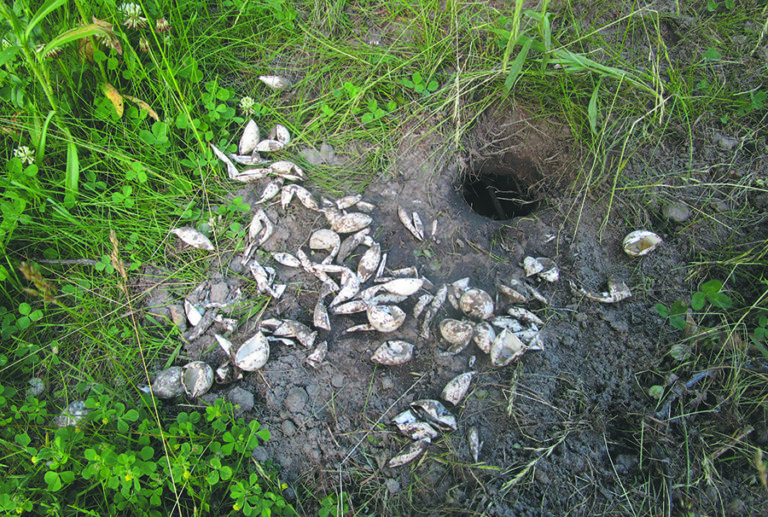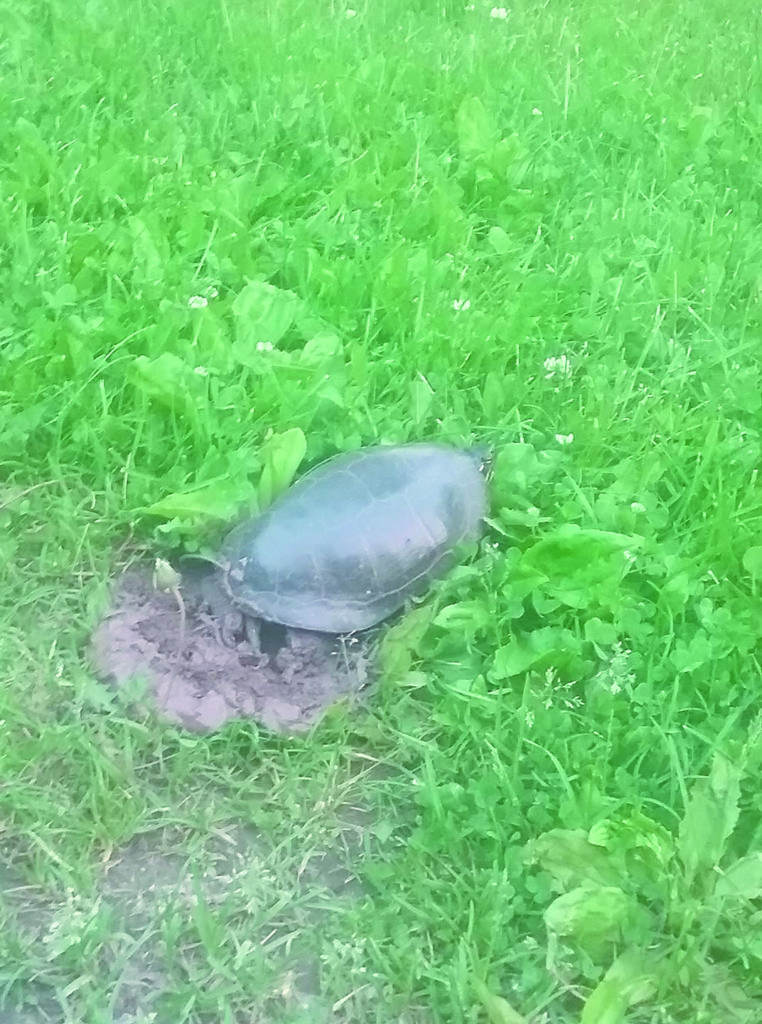

By Kathlean Wolf
Wild Warner
“A large snapping turtle is laying eggs in a mulch pile on a trail in the dog park,” Douglas posted on the Nextdoor website, and I replied in excitement, “I’ll come out and put a grating over it to keep dogs from digging it up.”
Twenty minutes later, I studied the disturbed surface of the mulch pile, pocked by a number of holes. Somewhere under there hid the hopes of an entire year for one mother snapping turtle. Searching, I broke through to a chamber filled with perfect spheres, each the diameter of a quarter; hundreds of embryos in white leather shells, slumbering in the self-warming compost pile. I carefully closed the nest up again. Fitting a metal grating over the nesting chamber, I tagged it with the message “turtle nest,” and then buried it beneath several more inches of mulch to avoid drawing attention.
Throughout the following weeks in June and July, turtle sightings became a common occurrence, and neighbors like Douglas expressed an interest in helping these beautiful reptiles to complete their nesting efforts safely. All of Wisconsin’s turtles face declining populations due to threats such as plastic entanglement, lead poisoning from abandoned fishing gear, and car strikes on females crossing roads in search of nesting sites. Warner Park is one of the few areas where our snapping, painted, Blandings and spiny softshell turtles can reach quality nesting sites without risking their lives crossing a road. In the face of all the threats to survival of these ancient animals, my experimental protection with a metal grating felt like a mere token, but over the months of June and July, my observations proved the opposite.
In past summers, I’d noticed a strip of land where emptied turtle egg shells would appear, scattered around small holes in the soil. Turtles favor the spot for its dry location and sun exposure, which helps warm the soil and incubate the eggs. Immediately after laying her eggs, a turtle mother carefully creates an earthen cap over the nest entrance, mixing her urine with soil to make a mud slurry that dries hard and disappears quickly into the background appearance of the environment. In September or October, tiny replicas of their fierce mother will come clambering out of the nest chamber all at once, racing for the waters of the nearby marsh. There they’ll seek the cover of cattails, muddy bottoms and banks, and search for tender water plants and insects to fuel their fight for survival.
Unfortunately, local predators also know this favorite sunny nesting site, and clear out nearly every nest almost as soon as they are made. Sniffing for the mixture of turtle urine and disturbed earth, predators generally find nests within the first day of laying, but if rain washes the scent away or a predator doesn’t locate it within a few days, the smell fades and the nestlings stand a chance of survival. At the end of June, I documented over 20 destroyed nests in this area, with two remaining unmolested as I write this, safe beneath my metal mesh. Other favored locations in the park suffer similar mortality.
This nesting site is a perfect laboratory for citizen-science, experimenting with ways to keep predators away from turtle eggs. Consulting an expert at the Wisconsin Turtle Conservation project, I’ve studied the effectiveness of metal gratings and chemical deterrents at keeping raccoons, foxes, skunks and other predators out of new nests. Next June, Wild Warner and partner groups will be ready to protect these nests and the mothers who lay them. With signs explaining how to help a turtle cross a road, well-made predator-deterrent nest coverings, and a program for dog park users who spot nesting turtles in their off-leash areas, June and July will hopefully be the start of a more successful breeding year for turtles, eventually helping to compensate for turtle mortality outside of the safety of our parks. Leaders of youth groups are invited to contact me at wolf.kathlean@zoho.com to discuss participation in this pilot project.